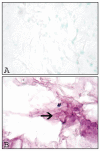Expression of interleukin-8 and intercellular cell adhesion molecule-1 in the synovial membrane and cranial cruciate ligament of dogs after rupture of the ligament
- PMID: 22754089
- PMCID: PMC3244294
Expression of interleukin-8 and intercellular cell adhesion molecule-1 in the synovial membrane and cranial cruciate ligament of dogs after rupture of the ligament
Abstract
This cross-sectional clinical study compared inflammation, including expression of the chemokine interleukin (IL)-8 and intercellular cell adhesion molecule-1 (ICAM-1), in the stifle joints of 4 control dogs and 23 dogs with cranial cruciate ligament rupture (CCLR). The CCL, synovial membrane, meniscus, cartilage, and synovial fluid from the affected stifle joints of all the dogs were examined. Inflammatory cell counts were performed on the synovial fluid, and the tissues were processed for histologic study and immunohistochemical detection of IL-8 and ICAM-1. The synovial fluid from the stifle joints of the dogs with CCLR had an increased percentage of neutrophils (P = 0.054) and a decreased percentage of lymphocytes (P = 0.004) but not macrophages compared with the fluid from the control dogs. There was accumulation of inflammatory cells and increased expression of IL-8 and ICAM-1 in the vascular endothelium of the synovial membrane and the CCL of the dogs with CCLR. The increase in inflammatory cells in the stifle joints of dogs with CCLR may therefore be due to increased expression of IL-8 and ICAM-1 in the synovial membrane and the CCL after the injury. These data may help in understanding the mechanisms of inflammation associated with CCLR.
Cette étude clinique par analyse transversale visait à comparer l’inflammation, incluant l’expression de l’interleukine (IL)-8 et de la molécule intercellulaire d’adhésion des cellules de type 1 (ICAM-1), dans les genoux de 4 chiens témoins et de 23 chiens avec rupture du ligament croisé cranial (RLCC). Le LCC, la membrane synoviale, les ménisques, le cartilage, et le liquide synovial provenant des articulations affectées de tous les chiens ont été examinés. Les dénombrements des cellules inflammatoires ont été effectués sur le liquide synovial, et les tissus ont été traités pour examen histologique et détection par immuno-histochimie d’IL-8 et d’ICAM-1. Comparativement au liquide synovial provenant des chiens témoins, le liquide synovial provenant de l’articulation du genou des chiens avec RLCC présentait une augmentation du pourcentage des neutrophiles (P = 0,054) et une diminution du pourcentage des lymphocytes (P = 0,004) mais pas des macrophages. Il y avait une augmentation des cellules inflammatoires et une augmentation de l’expression d’IL-8 et d’ICAM-1 dans l’endothélium vasculaire de la membrane synoviale et le LCC de chiens avec RLCC. L’augmentation des cellules inflammatoires dans les genoux de chiens avec RLCC pourrait ainsi être due à l’augmentation d’expression d’IL-8 et d’ICAM-1 dans la membrane synoviale et le LCC après la blessure. Ces données pourraient aider à comprendre le mécanisme de l’inflammation associée avec la RLCC.
(Traduit par Docteur Serge Messier)
Figures




References
-
- de Rooster H, de Bruin T, van Bree H. Morphologic and functional features of the canine cruciate ligaments. Vet Surg. 2006;35:769–780. - PubMed
-
- de Bruin T, de Rooster H, van Bree H, Cox E. Interleukin-8 mRNA expression in synovial fluid of canine stifle joints with osteoarthritis. Vet Immunol Immunopathol. 2005;108:387–397. Epub 2005 Aug 15. - PubMed
-
- Slocum B, Slocum TD. Tibial plateau leveling osteotomy for repair of cranial cruciate ligament rupture in the canine. Vet Clin North Am Small Anim Pract. 1993;23:777–795. - PubMed
-
- Vasseur PB, Berry CR. Progression of stifle osteoarthrosis following reconstruction of the cranial cruciate ligament in 21 dogs. JAm Anim Hosp Assoc. 1992;28:129–136.
-
- Doom M, de Bruin T, de Rooster H, van Bree H, Cox E. Immunopathological mechanisms in dogs with rupture of the cranial cruciate ligament. Vet Immunol Immunopathol. 2008;125:143–161. Epub 2008 Jun 3. - PubMed
Publication types
MeSH terms
Substances
Grants and funding
LinkOut - more resources
Full Text Sources
Miscellaneous
